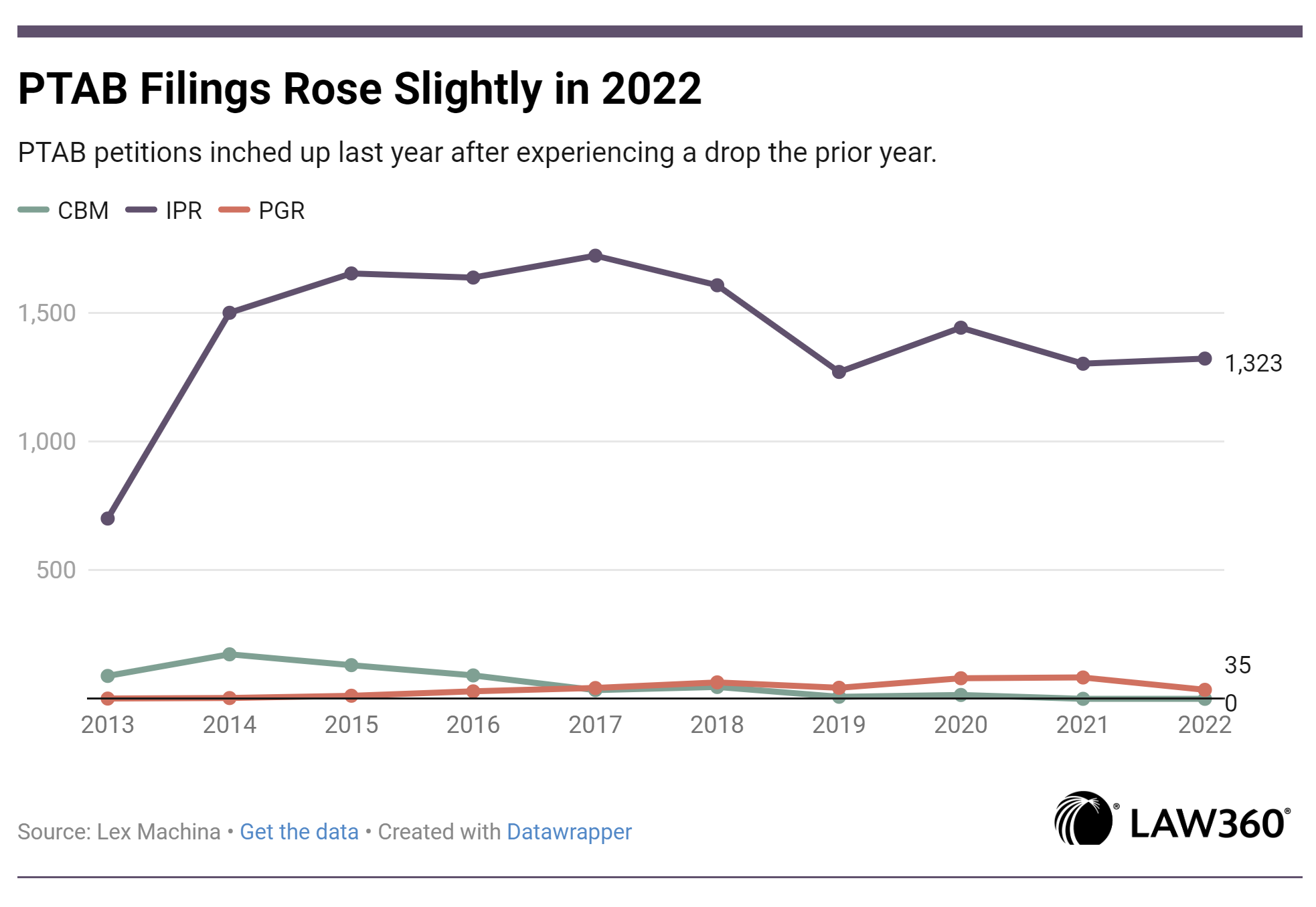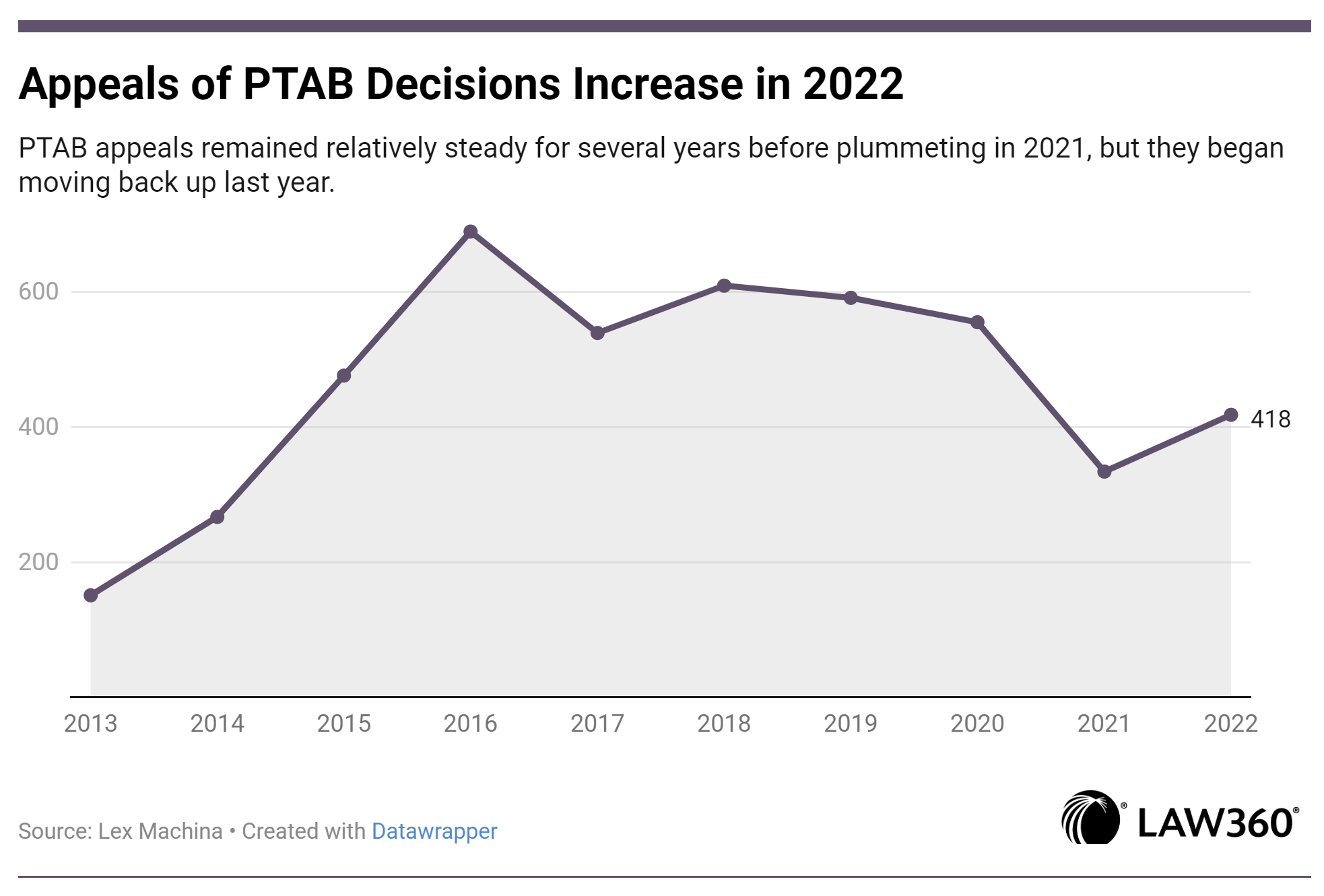By Andrew Karpan
Law360 (February 15, 2023, 8:37 PM EST) — Filings at the Patent Trial and Appeal Board inched upward in 2022, a trend lawyers say has to do with guidance from the patent office director last year limiting the board’s use of discretion to deny patent reviews.
Overall, patent challengers filed 1,323 petitions at the PTAB in 2022 compared to 1,303 petitions in 2021, a 1.5% increase, according to Lex Machina’s new patent litigation report. The number of decisions from the board that were appealed to the Federal Circuit went up as well, totaling 418 in 2022, compared to 334 the year before, a 25% jump.
The rise in these numbers is somewhat striking considering that they both dipped considerably in 2021, with attorneys attributing the drop at the time to the PTAB’s frequent use of discretionary denials under the board’s Fintiv decision. The decision, which was made precedential in May 2020, allowed the PTAB to deny patent reviews based on the status of related infringement litigation in district court. It came during the tenure of Trump administration U.S. Patent and Trademark Office Director Andrei Iancu, who was known for instituting policies tending to favor patent owners.
But in April 2022, President Joe Biden’s nominee to lead the USPTO — Kathi Vidal, the former head of Winston & Strawn LLP’s Silicon Valley office — was confirmed by the U.S. Senate. In her new role, Vidal issued guidance in June that has had the practical effect of deterring PTAB judges from using Fintiv to shoot down petitions.
“I think it’s fair to say that the board has ceased using Fintiv for the time being in all but the most extreme circumstances, and I think that’s given petitioners some certainty that they lacked during the last few years as to whether their merits will be considered,” Unified Patents’ general counsel Jonathan Stroud told Law360 in an interview.
According to Lex Machina’s report, Unified Patents filed 29 patent challenges last year, up from 24 in 2021.
Unified Patents is funded by companies including Google, Meta Platforms and, in more recent years, numerous car manufacturers in order to file challenges to what the organization calls “poor quality patents.”
Other major patent challengers that stepped up the number of petitions at the PTAB include Apple, which filed 137 petitions last year, compared to 69 in 2021, and Google, which filed 88 petitions last year, compared to 63 in 2021, according to the report.
Vidal’s move to rein in Fintiv appears to come from a “recognition that the time-to-trial statistics for district courts is really up in the air and cannot be relied on,” according to Jennifer Bailey of boutique firm Erise IP.
“She’s a really strong director, and she’s changing the USPTO from top to bottom, including at the PTAB,” said Bailey, who served as lead counsel on a petition from Garmin that ended up being the first inter partes review before the PTAB after the board was established by the America Invents Act in 2012.
Stroud of Unified Patents characterized the limits on Fintiv denials as a “comforting trend,” but said he was less sure that patent challenges would ever return to “pre-Iancu” levels. In 2017, the year the longtime Irell & Manella LLP partner took control of the USPTO, the PTAB saw a total of 1,723 petitions, an all-time high that has yet to be matched.
“People never talk about this, but the Iancu administration raised rates substantially on IPRs, and an IPR now costs upwards of $40,000 to file,” Stroud said.
“Litigations have gotten bigger. More patents are being asserted, and since it’s now more expensive to file, parties are often faced with tough economic decisions when deciding whether to use the board,” he added.
Richard Bemben, a director in Sterne Kessler Goldstein & Fox PLLC’s electronics practice whose firm splits somewhat evenly at representing patent challengers and patent owners, said he thinks Fintiv “is lying in wait for the unwary petitioner.”
Bemben said that while he appreciates seeing more patent decisions move “to the merits,” he expects petitioners will continue to keep both Fintiv and the progress of district court litigation in mind. He also endorsed the use of so-called Sotera stipulations, a reference to a different precedential decision at the PTAB that enables many patent challengers to clear the Fintiv bar if they stipulate not to pursue invalidity arguments in district court that they raised or could have reasonably raised at the patent board.
“As a patent owner, you want to make sure you’re analyzing [Fintiv] as well, so that if the situation is appropriate, you’re making those arguments,” Bemben said.
Lex Machina’s report also noted a slight increase in the percent of instituted PTAB trials, which went from 49% to 51% from 2021 to 2022.
Looking at patent board trial data between 2020 and 2022, the institution rate has remained around the 50% mark.
During that three-year span, 21% of petitions resulted in the PTAB finding that all of the challenged claims should not have been issued by the patent office, while 6% of petitions resulted in decisions that upheld the claims, according to the report. Another 6% resulted in mixed decisions, which invalidated some challenged claims and upheld others. In addition, 14% of the petitions ended in settlements before a review institution decision, while 13% ended in settlements after institution.
The report pointed out, however, that “24% of federal PTAB appellate cases that terminated from 2020 to 2022 were ultimately reversed.”
While the PTAB isn’t wielding discretionary denials as much as it used to, the board as a whole seems to be looking for alternative ways to deny patent challenges, according to Bailey of Erise IP.
Bailey said she is seeing more “scrutiny” from patent judges on the arguments that IPR petitions make for combining language from older patents or other publicly available published material in order to match the language used in the newer patents that lawyers like Bailey go to the board to challenge.
“It’s well understood within patent law that if you work hard enough, you can find every claim limitation, usually, in the prior art,” Bailey says. “I think the board has started to realize that and is using [its] technical chops to ask the question: Is there really a good reason why someone would have found this obvious?”
“The days of having a one-page motivation to combine are over,” she said.
–Editing by Jill Coffey and Emily Kokoll.

Receive insights from the most respected practitioners of IP law, straight to your inbox.
Subscribe for Updates

